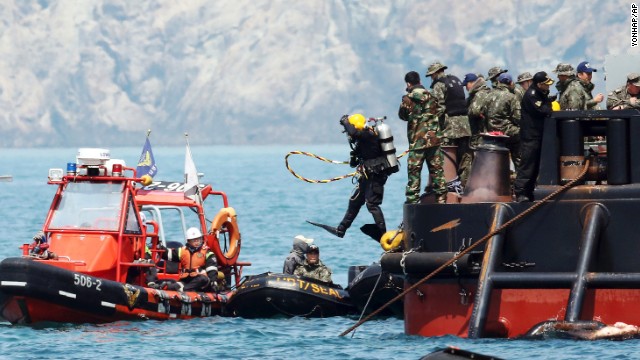Blame Aplenty
"The ship would suddenly fall even with just a small turn. It should not make a sharp turn."
"It should make a huge circle with one or two degrees of turn, but [the Sewol] made a small circle. So it fell."
Lee Kyu Yeul, professor emeritus in ship and offshore plant design, Seoul National University, Department of Naval Architecture and Ocean Engineering
 The sun sets over the site of the sunken ferry off the coast of the South Korean island of Jindo on April 22.
The sun sets over the site of the sunken ferry off the coast of the South Korean island of Jindo on April 22.
The captain claimed in paperwork that the ferry he was responsible for had on board 150 cars and 657 tons of additional cargo, according to the coast guard. A vice-president at Union Transport Co., which loaded the cargo into the Sewol stated that at the time it capsized and sank it was carrying an estimated 3,608 tons. That represents three times the weight that an inspector who examined the ship during a redesign declared it was safe to carry.
 Search personnel dive into the sea on Wednesday, April 23.
Search personnel dive into the sea on Wednesday, April 23. The Korean Register of Shipping inspector declared that changes made to the ship resulted in its inability to safely carry no more than around 1,000 tons of cargo. His report clarified that for that cargo, it would require 2,000 tons of water as ballast for stability. The ship was capable of handling over 2,500 tons of cargo requiring only 1,000 tons of water ballast, before it had undergone those modifications altering its capacity.
Despite which the shipowner, Chonghaejin Marine Co. Ltd. reported cargo capacity of 3,963 tons. The company had chosen to completely ignore the safety specifications outlined by the inspector, leaving the permitted tonnage capacity unaltered from what was permissible before the ship had undergone redesign.
Which led Lee Kyu Yeul, in his assessment of the situation and its dreadful outcome, to theorize that the reported load could very well have primed the ship to tip, with the impetus of a significant turn. The ship turned 45 degrees before sinking, according to tracking data. Evidence from crew members' reports related they had attempted to produce a much less pronounced turn, but were unsuccessful.
Divers have so far recovered just under 200 bodies. Families who lost loved ones have much to complain about, including that some of the recovered bodies were delivered to the wrong families; identification gone awry. "There have been cases where the victims were wrongly transferred", admitted the government-wide emergency task force.
 A diver jumps into the sea near the sunken ferry on Friday, April 25 Errors in identification has led to a new initiative where remains would be transferred to families henceforth only when an undeniable match could be achieved through more intensive processes using DNA testing, fingerprint, or dental records. Authorities have pledged to wait for more authoritative evidence than physical description before committing to a permanent transfer.
A diver jumps into the sea near the sunken ferry on Friday, April 25 Errors in identification has led to a new initiative where remains would be transferred to families henceforth only when an undeniable match could be achieved through more intensive processes using DNA testing, fingerprint, or dental records. Authorities have pledged to wait for more authoritative evidence than physical description before committing to a permanent transfer.Prosecutor Yang Jung-jin, representing the joint investigation team, declared the sinking could be related to excessive veering, improper cargo stowage, modifications made to the ship, and tidal influence. Simulations and consultations with experts are hoped to lead to a conclusive answer as to cause.
In the meantime, the captain and eleven members of his crew have been charged and arrested for negligence and abandonment of those in need, largely 300 young students. They represent the most immediate cause of the disaster, but as will undoubtedly become increasingly evident, the guilt and responsibility will be far more widespread.
Labels: Disaster, South Korea

<< Home